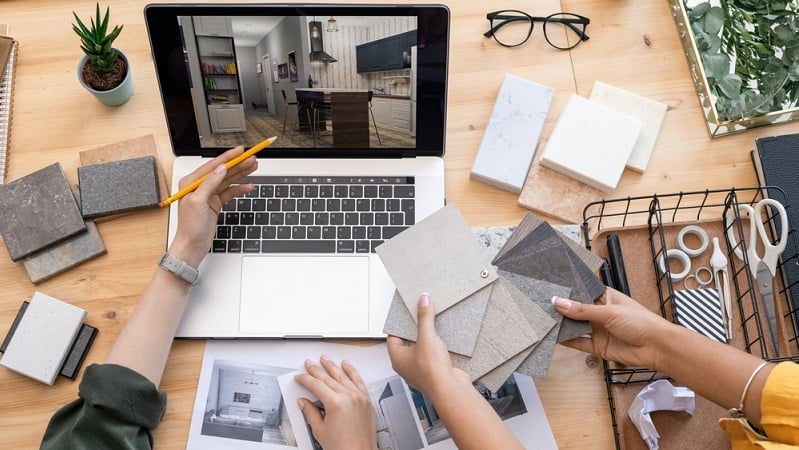In a world where curb appeal starts online and design inspiration scrolls past in seconds, marketing for interior designers isn't just nice to have, it's essential. Whether you're staging cozy nooks in small townhomes or transforming open-concept lofts in the city, how you promote your work can be just as impactful as the designs themselves.
But here's the good news: You don't need a huge budget or flashy ads to get noticed. Instead, focus on targeted strategies that engage with local audiences and create meaningful connections. Because your community—the neighbors walking by your window displays or the family down the street dreaming of a kitchen update—is just a few digital steps away.
Let's walk through the interior design marketing strategies that can help you reach the right people, showcase your talent, and build lasting neighborhood connections.
Understand and define your target audience
Before you start any marketing efforts, like snapping project photos or drafting blog emails, let's define your ideal customers. Effective marketing without a clearly defined target audience is like decorating a room blindly.
Identify your ideal client
Think about who lights up when they see your style. Are they young professionals furnishing their first home? Families renovating for more functional space? Empty nesters downsizing with style? By identifying potential clients and understanding their interior design needs, you can position your brand effectively in the market.
Platforms like Nextdoor can help you get granular. You can peek into local discussions, learn which zip codes are buzzing about remodels, and see what kinds of homes your neighbors live in. Someone in a historic neighborhood might be dreaming about preserving charm with a modern twist. Someone in a new building may want help making their blank canvas feel like home.
The more you know, the better your messaging can be. Speak their language. Solve their problems. Design for their lifestyle.
Build a strong online presence
Your online presence is often the first impression people have of your business. Like the foyer of a well-designed home, it should be welcoming, easy to navigate, and reflective of your style.
Create a professional website
This is crucial for establishing your brand identity in the competitive interior design business industry. A polished website does more than look pretty. It should be functional, build your brand, and help you connect with clients to grow your business. Include the following information:
- A portfolio with high-quality images of past projects
- A clear list of services you offer
- Testimonials from clients
- Simple contact info or a scheduling tool
And don't forget to enhance the mobile version. Many folks will find you on their phone, whether through a Nextdoor post or a Google search. Make sure everything loads fast and reads easily on a small screen.
Optimize for visual platforms
Interior design is visual storytelling. With diverse social media platforms like Instagram and Pinterest, your creativity and brand story can truly shine. These platforms expand your brand's reach while attracting new followers. But it's not just about posting pretty pictures—it's about staying consistent.
Choose a color palette, font style, and tone that reflect your brand. Share more than finished photos: post mood boards, material samples, behind-the-scenes peeks, and yes, even the occasional mess. Authenticity goes a long way, especially when paired with your professional eye. You're not just showing rooms, you're inviting potential clients into your process.
Analyze local design needs
A look that resonates in a coastal neighborhood might feel out of place in a wooded suburb. That's why it's so important to understand your community's preferences.
Review conversations in local forums
Nextdoor is a goldmine for insights. Look into these digital marketing insights to develop strategies that solve common local interior design problems. You'll find real people talking about their real design challenges, like wanting to make their rooms feel bigger, painting different items around their house, or identifying types of flooring for different purposes.
These threads reveal not just needs, but language. Use what you learn to tailor your messaging. If your neighbors are asking about ways to make their space cozier or easier to maintain, speak directly to those concerns in your posts and service descriptions. This is one way you can do customer experience marketing.
Explore neighborhood-specific trends
Design preferences can vary wildly, even across town. Are locals leaning into open shelves and natural light? Do older homes in your area need thoughtful storage solutions? Are people craving warm textures over minimalist styles?
Take the time to observe community trends and develop strategic ideas to adjust your services accordingly. Mention your understanding of local styles in your content. It shows that you're not just a designer; you're a neighbor who gets it.
Use Nextdoor to reach local clients
This is where it all comes together. Once you've defined your audience, polished your website, and scoped out community trends, it's time to connect and expand your marketing reach.
Set up a Business Page on Nextdoor
Your Nextdoor Business Page serves as your storefront in the neighborhood. Here, you can:
- Share project highlights and blog posts
- Post updates, promotions, or seasonal offers
- Collect and display reviews from happy clients
- Be tagged and recommended by neighbors
And it's all grounded in real relationships. People on Nextdoor trust recommendations from folks who live nearby. Your work can spread through word-of-mouth at digital speed.
Share project updates and design tips
Don't be afraid to talk shop; just keep it friendly. Post updates when you finish a project, and include before-and-after photos. Share tips on trendy designs or seasonal colors to spruce up neighbors' living spaces. Even small notes on how to choose the right rug size or ways to brighten a room with plants can start conversations. And when people feel helped, they remember you.
Leverage content marketing
Content isn't just for clicks. It's a way to build authority, share your point of view, and show up when potential clients go searching for interior design advice. Create engaging content that aligns with your marketing strategy.
Publish helpful blog content
Think of your blog as an extension of a friendly chat over coffee. Recall the questions clients ask you all the time, and turn those into posts. Possible blog ideas could include:
- Budget-friendly design swaps
- How to style open shelving without clutter
- Decorating tips for small spaces
- Seasonal design trends for your region
Make your blogs keyword-friendly—think "interior design marketing" or "best paint colors for small rooms," but don't force it. Keep the tone inviting and neighborly. This approach will create trust and make your services more appealing.
Highlight before-and-after projects
People love a good transformation story. It's a type of advertising that speaks to people. Start with the challenge, then walk readers through your process, decision-making, and the result. Include photos and personal touches.
Did the homeowners have a quirky collection they wanted to feature? Did you repurpose a vintage piece from a local shop?
Those details matter. Your website should showcase images that highlight the process behind your work. Share the full story on your blog, then break it into bite-sized moments for social media and Nextdoor posts.
Engage with the community
People will hire you as an interior designer because they trust you with the feel and function of their home. That kind of trust is built in person just as much as online, so don't be a stranger.
Participate in local events
Homeowners love seeing local talent up close. Hosting or joining events is a natural way to show off your work and meet potential clients without the hard sell. Consider participating in the following activities:
- Popping up at a neighborhood fair with a mini design booth
- Hosting an open house or model home tour with a realtor
- Leading a workshop on seasonal decorating or small-space styling
And don't forget to promote it! Marketing your services within such events will enhance your brand's reach. Post on your business page, tag local businesses involved, and share photos afterward. Even if someone didn't attend, they'll see that you're active, helpful, and rooted in the community.
Collaborate with complementary local businesses
Teaming up with others in your ecosystem can amplify your reach in the best way. Think about realtors who need staging services, contractors with clients needing finishing touches, and local shops selling décor, plants, or furnishings.
A quick "neighbor spotlight" on Nextdoor or a joint giveaway on Instagram can go a long way. Cross-promotion helps each business grow, and it shows clients you're trusted by other professionals in town.
Drive growth through social proof
What neighbors say about you carries more weight than anything you post yourself. That's why building and sharing social proof is such a vital piece of any interior design marketing strategy.
Encourage reviews and testimonials
Happy clients are often thrilled to spread the word—you just need to ask. After a project wraps up, send a quick thank-you and request a recommendation on Nextdoor or Google review. Make it easy with a direct link. Then, feature those kind words on your website's homepage or testimonial page, social media graphics, printed materials like flyers or postcards, or your Nextdoor bio.
You're not bragging, you're building trust. A review from a real neighbor might be all it takes for someone on the fence to reach out. And even if a review isn’t so positive, it’s still a way for you to learn how to improve customer experience.
Launch a referral program
Word-of-mouth is alive and well, especially in neighborhoods where people still wave at each other from the porch. Make it even easier for happy clients to share your name with a simple referral program.
For example, you can offer a discount or gift card for every new client they send your way. You can also give both the referrer and the new client a small perk, like a design consultation or home décor goodie.
Keep it light and fun. Mention it in your email newsletters, leave a flyer after completing a project, or bring it up during a final walkthrough. People want to help their neighbors, and you, for doing a great job with their homes.
Become your neighborhood's go-to interior designer with Nextdoor
Marketing for interior designers doesn't have to mean massive ad budgets or polished sales pitches. At its heart, it's about consistently and authentically showing up in the places where trust is built. By understanding your audience, creating a standout online presence, joining neighborhood conversations, and inviting others to share your story, you plant the seeds for real, lasting relationships.
Nextdoor makes that even more powerful by grounding your work in your local community, where a well-placed rug or a refreshed room can truly change someone's day-to-day life. 75% of Nextdoor users are homeowners. When you show up where your neighbors already gather, marketing becomes less about selling and more about connecting.
So, whether you're just starting out or looking to grow your studio, don't overlook the impact of a simple human connection. Your next project might be just a few doors—or posts—away.






